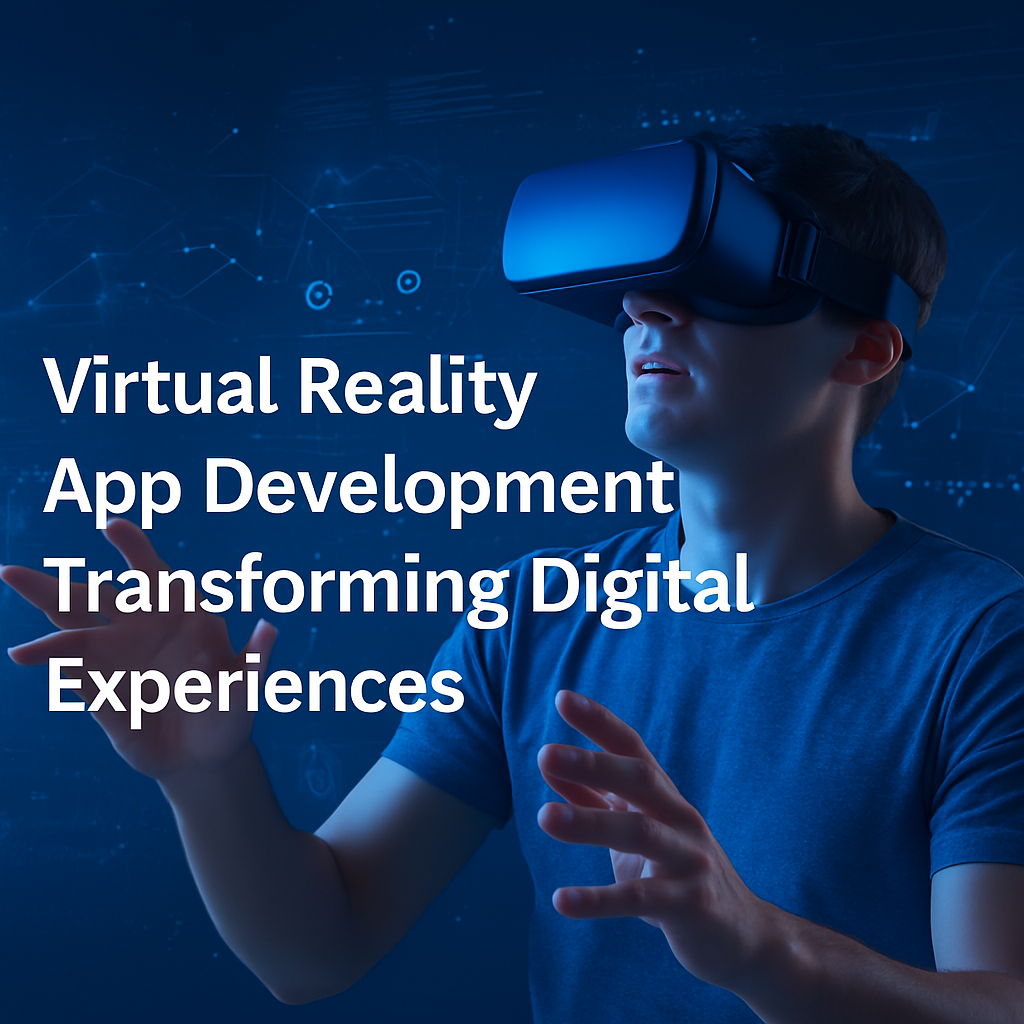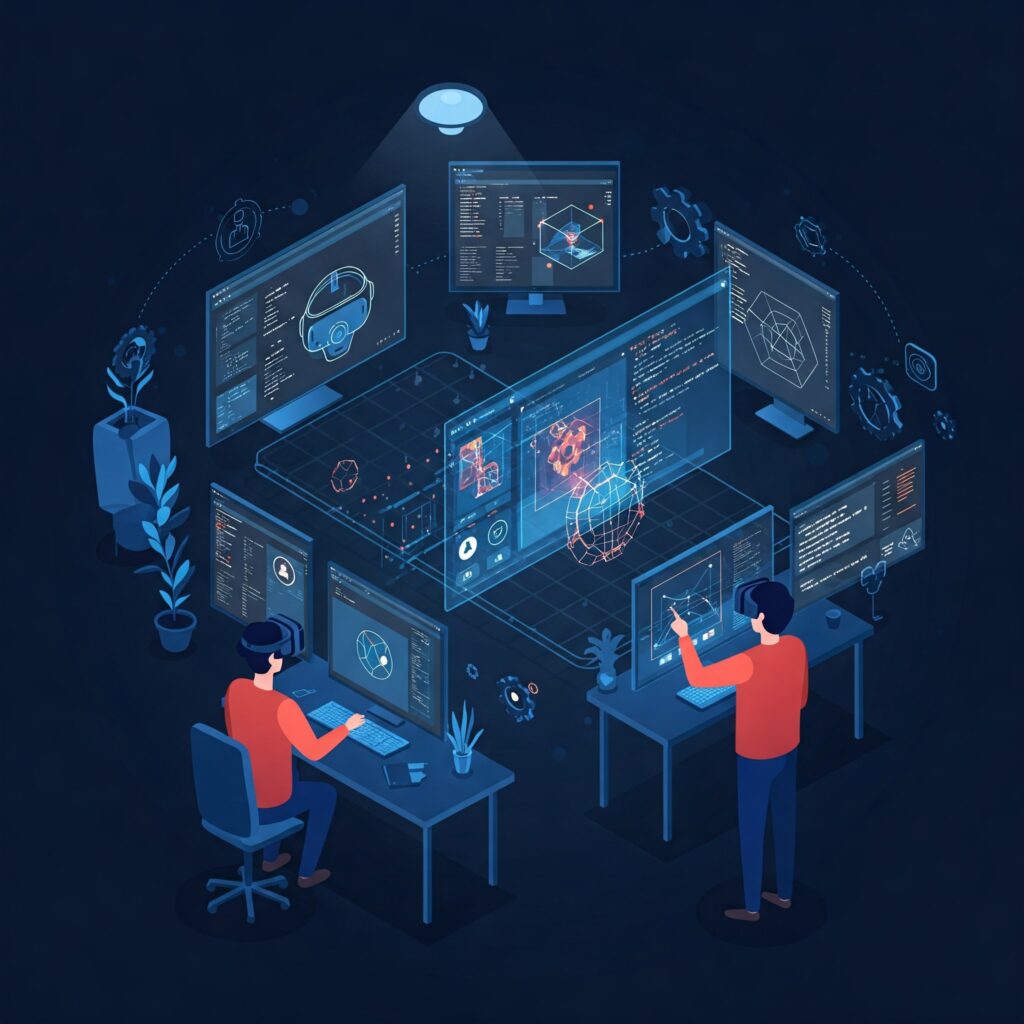It is not about future; VR is shaping industries worldwide today. It has changed the way people engage with digital environments in industries such as gaming, health care, education, and real estate. Virtual reality app development would afford a company or developer the opportunity to create such really stylish applications through which users can virtually be placed into a digital simulated experience. This post will discuss basic definitions and tools involved in the process of developing VR applications, the various applications relevant to specific industries, and the anticipated hurdles and future directions.

Understanding Virtual Reality App Development
What is Virtual Reality?
Virtual Reality or VR is a simulated digital environment that can be interacted with by users with the help of a VR headset, controllers, and many more accessories. As opposed to Augmented Reality which superimposes the digital elements into the real world, VR takes full advantage of immersion.
Core Components of VR Application Development
Here’s a few hardware like Software and developing frameworks that the developers need to create virtual reality applications:
- Hardware: VR headsets (Oculus Rift, HTC Vive, PlayStation VR), motion controllers, haptics feedback devices.
- Software: Unity, Unreal Engine, A-Frame, and WebVR.
- Programming languages: C#, C++, Python, and JavaScript.
- APIs and SDKs: Oculus SDK, Google VR SDK, ARCore, OpenVR.
Key Steps to Build a Virtual Reality App
- Planning & Research
Before the actual VR application development, it is essential that developers establish the purposes of the app, its audience, and the compatible platforms. The research done should encompass user behavior and industry trend activities, ensuring a competitive advantage.
- Choosing a VR Development Engine
There are mainly two engines which dominate the VR development prospect:
- Unity: For cross-platform VR Apps; uses C#.
- Unreal Engine: Suitable for high-end VR applications that require photorealistic graphics.
- Designing the User Experience (UX)
VR must be very intuitive and immersive from an interactive standpoint. Developers can focus on:
- Comfort and Accessibility: Speeding up the reduction of motion sickness.
- 360° Interaction: Making the world fully explorable.
- Realistic Graphics and Audio: To pull users in further.
- Coding & Development
Implementing Android VR development using Android Studio & ARCore.
You must integrate gesture controls and spatial tracking.
Test performance using different hardware for VR.
- Testing & Debugging
Testing VR apps is essential to maintain frame rate, user comfort, and workability. For this purpose, developers rely on tools such as Oculus Debug Tool, VR Performance Toolkit, and SteamVR Performance Test.

Tools & Technologies for VR App Development
VR Development Platforms
- Unity: It allows multiple VR headsets, has a very large asset store, and a very comfortable interface for developers at all levels.
- Unreal Engine: Bringing high-end rendering, Unreal Engine is one of the finest sources available for very high-fidelity VR applications, primarily in gaming and architectural visualization.
- A-Frame & WebVR: These allow developers to create web-based VR experiences that run directly in browsers, making them more available without need for high-end hardware.
Programming Languages & SDKs
- C#, C++, JavaScript: Generally used in VR applications to develop interactive and responsive environments for VR.
- VR SDKs: Google VR SDK, Oculus SDK, and ARCore fall in the category of essential developer tools needed to build AR VR mobile apps and ensure cross-vendor compatibility across several VR platforms.
Industry-Specific Applications of VR Apps
- Gaming and Entertainment
VR has changed the whole game in gaming by developing fully-packed 3D environments with haptic feedback and motion tracking. Some of the classic VR games include of Half-Life: Alyx, Beat Saber, and Resident Evil 4 VR.
- Healthcare Services
Virtual reality is becoming used in simulation within a medical practice: virtual physical therapy and mind treatment. For surgeons, now using VR, their practice can be done in a completely risk-free, virtual environment.
- Education and Training
VR takes learning into a new, spectacular dimension with virtual classrooms and even industrial training programs. In awesome destinations, students can be made to go through their experiments as if they were in a lab.
- Real Estate and Architecture
Virtual real estate Android app development offers virtual property previews by real estate companies. Before the construction of buildings, architects are able to design and visualize their buildings.
Challenges in Developing Virtual Reality Applications
VR app development, though advantageous, presents a gamut of challenges.
Expensive Development
The development of virtual reality applications requires specialized hardware and software tools where initial costs are exorbitantly high. Furthermore, high-definition graphics, precise tracking systems, and the need for seamless interaction will add to the expenses incurred.
Performance Optimization
The performance must be smooth and lag-free. Low frame rates or latency can cause motion sickness that takes away from the user experience. Developers are to optimize rendering, reduce latency, and maintain a steady frame rate of around 90 FPS for smooth interactions.
User Adaptation
While certain users manage pretty well to utilize a virtual environment, some feel discomforting, disoriented, or even nauseated in some cases. To mitigate this discomfort, ergonomic design and intuitive control mechanisms must be a paramount consideration for the developers.
Cross-Platform Compatibility
VR apps should run on multiple headsets, operating systems, and platforms-Oculus, HTC Vive, PlayStation VR, and mobile standalone VR. And keeping them run smooth across different hardware-software ecosystems is a feat in itself.
Future Trends in VR App Development
Integration of AI with Machine Learning
Applications of AI in Virtual Reality personalize user experiences, improve NPC interactions in games, and even create some of the most complex simulations.
Virtual Reality Experiences through 5G Networks
5G will very much remove latency in the VR content streaming technology, enabling real-time streaming without lag.
Virtual Reality Based on the Cloud
Cloud computing opens the doors for customized virtual reality app development, allowing people to familiarize themselves without the need for any heavy-end hardware.
The Increasing Dominance of WebVR
Web-based VR experiences will make VR mainstream, bringing all experiences within reach of the browser-a user will not have to install any other software for VR content consumption.
Conclusion
As far as virtual reality app development is concerned, it is changing the whole vista of digital experiences in all industries. Advancing with time will make future applications even more affordable, immersive, and impactful in the sense of virtual reality. It doesn’t matter if it is gaming, healthcare, or education; investing in VR application development is just one of the very exciting opportunities for developers and businesses today. When bundled with appropriate tools, frameworks, and best practices, developers can create next-level virtual experiences to redefine user engagement.




